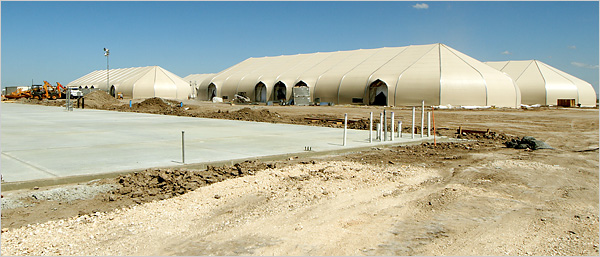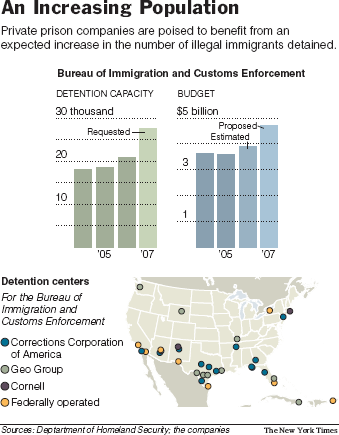| Want to send this page or a link to a friend? Click on mail at the top of this window. |
More Special Reports |
| Posted July 19, 2006 |
| Immigration Enforcement Benefits Prison Firms |
 |
The New York Times |
| Holding center for people accused of illegal immigration are built in 24-hour-a-day construction of Raymonsville, Tex. |
By MEREDITH KOLODNER |
AS the Bush administration gets tougher on illegal immigration and increases its spending on enforcement, some of the biggest beneficiaries may be the companies that have been building and running private prisons around the country.
By the fall of 2007, the administration expects that about 27,500 immigrants will be in detention each night, an increase of 6,700 over the current number in custody. At the average cost these days of $95 a night, that adds up to an estimated total annual cost of nearly $1 billion.
The Corrections Corporation of America and the Geo Group (formerly the Wackenhut Corrections Corporation) — the two biggest prison operators — now house a total of fewer than 20 percent of the immigrants in detention. But along with several smaller companies, they are jockeying for a bigger piece of the growing business.
Corrections Corp. and Geo are already running 8 of the 16 federal detention centers.
With all the federal centers now filled and the federal government not planning to build more, most of the new money is expected to go to private companies or to county governments. Even some of the money paid to counties, which currently hold 57 percent of the immigrants in detention, will end up in the pockets of the private companies, since they manage a number of the county jails.
“Private companies are positioning themselves as suppliers, and are positioned to take the majority of new beds available,” said Anton High, an analyst with Jefferies & Company, the brokerage firm. He has recommended that his clients buy Corrections stock.
Louise Gilchrist, vice president for marketing and communication at Corrections Corp., said her company would have no trouble meeting the federal government’s needs. “We believe as their demand increases, they will need to rely on providers who have bed space available,” she said. “The company feels it is well positioned.” Wall Street has taken notice of the potential growth in the industry. The stock of Corrections Corp. has climbed to $53.77 from $42.50, an increase of about 27 percent, since February when President Bush proposed adding to spending on immigrant detention. Geo’s stock rose about 68 percent in the period, to $39.24 a share from $23.36.
 |
The increasing privatization of immigrant detention has its critics. Immigrant advocates say health care at some centers has fallen short. They contend that some centers have treated immigrants as if they are criminals — restricting their movements unnecessarily, for instance — even though many are still awaiting a ruling on their legal status.
Because those who cross the border illegally are not considered criminals, they are not automatically assigned a lawyer. But, the advocates say, there have been repeated instances when immigrants have not had access to working phones to call for legal assistance.
“Private prisons have unleashed an entrepreneurial spirit in this country that is unhealthy,” said Judith Greene, director of the nonprofit research group Justice Strategies. “Standards are violated on a regular basis in order to cut costs.”
The companies counter that they are living up to their contractual obligations. “If you develop a reputation as a company that cuts corners, you will lose your contracts,” said Steve Owen, director of marketing at Corrections. The allegations, he added, “are completely false.”
Immigration experts say the need for more prison space is not a result of an increase in the number of people entering the United States illegally. According to the Pew Hispanic Center in Washington, the number of unauthorized immigrants arriving in this country is down by about 50,000 a year from the late 1990’s.
Instead, the increase in spending on detention is part of a crackdown on illegal residents living in the United States as well as an expected increase in the number of immigrants captured as they try to cross the border.
The government also plans to detain more immigrants, especially those from countries other than Mexico, while they await their hearings, instead of releasing them on their own recognizance. This effort to end what is known as “catch and release” means more capacity is needed immediately.
“The issue is not how many immigrants,’’ said Joe Onek, a senior policy analyst at the Open Society Institute. “There’s incredible pressure on the administration from members of its own party and from some sectors of the population to crack down.”
Revenues for the prison management companies will grow not only because of the rising number of detainees, but also because profit margins are higher at detention centers than prisons, analysts say.
Last year, the Correction Corp.’s revenue from holding immigrants jumped 21 percent, to $95 million from $70 million in 2004. Geo, the second largest prison operator, received $30.6 million last year, about the same as the year before.
While the companies would not comment on profit margins from their immigration business, Wall Street analysts said that detention centers produce profit margins of more than 20 percent.
That compares with margins in the mid-teens for traditional prison management, they said, because prisoners are provided with more costly services like high school degree programs and recreational activities.
Even with the expected growth in the number of immigrant detainees, the main source of income for the private prison companies will continue to be revenue from state and federal governments for housing regular inmates.
The state and local prison population totaled more than 1.5 million last year, with about 100,000 of those held in privately managed prisons. But the number of state and federal inmates rose by just 1.4 percent from June 2004 to June 2005, slower growth than the average 4.3 percent annual increases from 1995 to 2000.
By contrast, the number of immigrants in detention is expected to increase by about 20 percent over the next three months alone.
Federal immigration contracts generated about $95.2 million, or 8 percent, of Correction Corp.’s $1.19 billion in revenue last year, and about $30.6 million, or 5 percent, of Geo’s $612 million total income.
In the first quarter of 2006, Corrections Corp.’s detention revenue rose to $25.5 million. The federal immigration agency is now the company’s third-largest customer, after the federal Bureau of Prisons and the United States Marshals Service.
The detention market is projected to increase by $200 million to $250 million over the next 12 to 18 months, according to Patrick Swindle, a managing director at Avondale L.L.C., an investment banking firm that has done business with both Geo and Corrections Corp. He said that a company’s capacity would play an important role in how much of the market it would be able to capture.
The company “currently has 4,000 empty beds in their system,” Mr. Swindle said. “They are bringing on an additional 1,500 beds within the border region.’’
“Reasonably, about 3,000 to 4,000 beds could be made available” for immigrant detention, he said.
Having empty cell space that can be made available quickly is considered an advantage in the industry since the government’s need for prison space is often immediate and unpredictable. Decisions about where to detain an immigrant are based on what is nearby and available. Immigration officials consider the logistics and cost of transportation to the detention center and out of the country.
“We can use the beds whenever and wherever we like,” said Jamie Zuieback, a spokeswoman for United States Immigration and Customs Enforcement. “We are funded for a certain number of beds but there are many beds around the country that are available and it depends where and when we need them if we use them.’’
While companies do not release how much space they currently have available, analysts estimate that Geo has about 1,500 empty places. To increase capacity, the company announced in June that it was building a 576-inmate expansion of the 875-inmate Val Verde Correctional Facility it owns in Del Rio, Tex.
George C. Oley, Geo’s chief executive, said in a statement at the time of the Val Verde announcement: “We are moving forward with the expansion of this important facility in anticipation of the expected increased demand for detention bed space by the Federal Government.”
Despite the two companies’ dominance, they face competition from smaller players in the corrections business. A new federal detention center set to open in Texas at the end of July will be run by the Management and Training Corporation, a privately owned company based in Utah.
The Cornell Companies, based in Texas, currently operates two centers that hold detainees. It is the third-biggest private corrections company, though significantly smaller than Corrections Corp. and Geo, controlling just 7 or 8 percent of the market, according to Mr. Swindle.
“What’s great about the detention business,” Mr. High of Jefferies said, “is not that it’s a brand-new channel of demand, but that it is growing and significant.”
Copyright 2006 The New York Times Company. Reprinted from The New York Times, Business, of Wednesday, July 19, 2006.
Related text: The Immigration Equation
| Wehaitians.com, the scholarly journal of democracy and human rights |
| More from wehaitians.com |